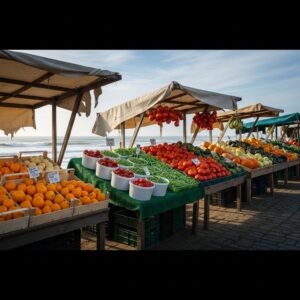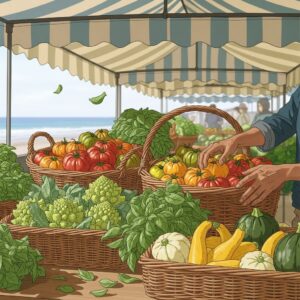Start Strong: Your First Fresh Market Visit in Naperville
Beginning your journey at a fresh market in Naperville, Illinois is exciting, flavorful, and easier than you might think. The energy of local growers, the scent of ripe fruit, and the buzz around seasonal specialties can be both inspiring and a little overwhelming for first-timers. The key is to arrive with a flexible plan and a few practical tactics you can use immediately. Check the current weekly deals to understand what is abundant right now, bring a roomy bag and a small cooler pack for perishable items, and be ready to ask questions. Vendors are thrilled to help you select the best ripeness for your recipe, share cooking suggestions, and point out varieties that are at their peak today.
As a beginner, you do not need to know every apple variety or the difference between heirloom and hybrid tomatoes. You simply need a framework that helps you shop efficiently without missing discoveries. Think of your first trip as a tasting tour with a small shopping list. Pick two or three categories you care about most—like salad greens, fruit for snacks, and a protein from a local producer—then let the market surprise you with an herb bundle or a vegetable you have never tried. This balanced approach gives structure to your cart while leaving room for fun.
What to Bring and How to Prepare
Comfortable shoes and layered clothing make your visit more enjoyable, especially in fickle Midwest weather. A reusable tote or rolling cart prevents crushed produce and keeps your hands free. If you plan to buy eggs, dairy, or meats, a small cooler insert protects your items during a leisurely stroll. A simple list on your phone helps you stay focused: include staples you know you will use this week and one or two wild cards for experimentation. Some shoppers like to bring a notebook to jot down vendor recommendations or specific varieties they enjoy for future reference.
Check local market schedules for special activities like chef demonstrations, live music, or kids’ programming. These events not only add entertainment but also provide quick lessons in cooking and storage. If you plan to attend a demo, arrive early to secure a good view and be ready to ask how to adapt the recipe for different diets or ingredients. Because markets can get busy, decide in advance where you will meet friends or family if you get separated, and agree on a time to regroup.
Timing Your Visit
Arriving near opening time gives you the widest selection and the crispest produce. If you are after a specific item—like the first strawberries of the season—do not wait. On the other hand, visiting later in the day offers a more relaxed pace, which some beginners find less intimidating. Keep in mind that popular items may sell out by midday. Over time you will learn the ebb and flow of your local market, including which vendors consistently have lines and which stalls are hidden gems that reward the careful observer.
Weather matters. After a heavy rain, root vegetables might be abundant and especially clean, while delicate items can be more limited. On hot days, plan to shop for perishable goods first and keep them shaded in your bag. If you feel rushed, step aside to a quiet corner to reorganize and review your list. Take a minute to breathe, savor the atmosphere, and let your senses guide your next stop.
How to Talk to Vendors
Begin with a friendly greeting and a simple question: What is tasting amazing today? This invites growers to steer you toward the best of their harvest and often leads to a quick sampling. If you are choosing fruit, ask how soon it will be ripe and whether it is better for baking, snacking, or salads. For vegetables, inquire about texture, sweetness, and the best cooking methods. When you find something new, ask how the vendor prepares it at home. These conversations are not just informative; they make shopping more enjoyable and help you remember what you liked.
Do not be shy about requesting smaller or larger quantities. Many vendors will split a basket or combine items to match your needs. If you are cooking for one or two people, buying just enough prevents waste. If you are feeding a group, ask which varieties hold up best when cooked in bulk or stored for a few days. The more you communicate your plans, the better guidance you will receive.
Smart Selection and Storage Basics
Visual and tactile cues are your best tools. Look for vibrant color, firm but not hard textures for most fruit, and crisp leaves without excessive wilting. For tomatoes, a gentle fragrance near the stem and a slight give under light pressure indicate ripeness. For greens, choose bunches that look lively and hydrated; they should bounce back when you lightly squeeze the stems. Eggs should be clean and cool, cheese should be well-wrapped, and meat should go into your cooler promptly. Once home, store tomatoes on the counter, keep leafy greens dry and tucked into breathable containers, and label any prepped produce with the date so you remember what to use first.
As you become more comfortable, build a rotation of favorite items that suit your cooking style. If you love quick stir-fries, stock up on snap peas, baby bok choy, and thin-skinned peppers when you see them. If sheet-pan dinners are your go-to, look for potatoes, onions, carrots, and seasonal squash. This habit streamlines decision-making and minimizes midweek grocery runs.
Meal Planning the Beginner-Friendly Way
Plan around a few core dishes that use overlapping ingredients. For example, buy a mix of greens, tomatoes, cucumbers, and herbs to create salads, wraps, and grain bowls throughout the week. Add a seasonal fruit for breakfast parfaits and a simple protein to anchor dinners. Choose one special item—such as artisan bread or a unique cheese—to elevate your meals without complicated recipes. This structure ensures variety while keeping your kitchen time manageable.
Get comfortable with simple cooking methods that flatter fresh ingredients. Roasting concentrates flavors, sautéing preserves crisp textures, and quick pickling adds bright acidity. If you prefer minimal cooking, assemble no-cook plates with sliced vegetables, hummus from a specialty stand, and a sprinkle of herbs. These small techniques encourage you to use everything you buy and reduce the chance of forgotten produce in the crisper.
Finding Confidence Through Seasonal Awareness
Markets in Naperville mirror the seasons closely, so letting the calendar guide your choices is smart. In spring, tender greens and radishes shout for quick salads. In summer, tomatoes, zucchini, melons, and sweet corn become effortless meal starters. Fall welcomes apples, squash, and sturdy greens that love roasting and braising. Winter markets, when available, feature storage crops and specialty items perfect for soups and slow-cooked dishes. Awareness of this cycle helps you anticipate what will taste best and plan recipes accordingly.
To keep your learning curve gentle, focus on one new ingredient at a time. If you bring home an unfamiliar pepper variety, try it raw, then sautéed, then roasted to see how the flavor changes. Ask the vendor about heat levels and pairings—some peppers shine in salsas, while others are better in stews. With this approach, your skills grow steadily without the stress of juggling too many unknowns at once.
Midway Check-In and Adjustments
Halfway through your visit, pause and review your bag. Do you already have enough salad greens? Are you missing a starch to round out dinners? This quick check prevents impulse purchases that do not fit your plan and helps you spot gaps. If you are inspired by a cooking demo or a neighbor’s suggestion, swap a less exciting item for something you will be thrilled to use. For additional inspiration on what to add to your list next time, scan the current weekly deals and note which items appear consistently over several weeks. Steady availability makes meal planning easier and reduces decision fatigue.
Consider building a simple prep routine when you return home. Spend 30 minutes washing greens, cutting carrot sticks, and roasting a tray of mixed vegetables. This brief investment makes healthy choices automatic and prevents waste. Label containers and keep them visible so you remember what to use first. The more you streamline your routine, the more enjoyable your market habit becomes.
Beginner Mistakes to Avoid
Do not buy more than you can eat in a few days, especially with delicate produce. Avoid shopping hungry, which can lead to overbuying. Resist the urge to purchase complicated specialty items until you have a plan for using them. If you are unsure about storage, ask before you leave the stall; incorrect handling is a common reason for disappointment. Finally, give yourself permission to experiment and learn—mistakes are part of becoming a confident market shopper.
Another avoidable misstep is skipping conversation. Quietly browsing has its place, but markets reward curiosity. That quick chat about ripeness or recipe ideas can be the difference between a good meal and a great one. Over time, you will identify your favorite growers and develop trust that guides your weekly decisions.
Frequently Asked Questions
Q: How much should I buy on my first trip? A: Plan for three to five meals and purchase only what you are confident you will use in the next few days. Add one small experimental item to keep it fun.
Q: What if I do not recognize a variety? A: Ask the vendor how it differs from similar items and request cooking tips. Many farmers have quick recipes they share with customers.
Q: Can I taste before buying? A: Many stalls offer samples when feasible. Always ask first and follow any posted guidelines.
Q: How should I store herbs? A: Trim the stems, place them in a jar with a little water, and loosely cover in the refrigerator. Change the water every day or two to keep them fresh.
Q: Are there options for special diets? A: Yes. You will find gluten-free baked goods, plant-based proteins, and dairy alternatives at many markets. Vendors can help you verify ingredients.
Step Into the Market with Confidence
You are ready for a smooth first visit: arrive early for selection, carry a roomy bag, chat with vendors, and plan simple meals around seasonal stars. Keep your list flexible and your curiosity high, and you will quickly build a market routine that feels effortless. When you are planning your next outing, take a moment to browse the latest weekly deals, jot down a few recipe ideas, and set aside a little time for post-shopping prep. With these beginner-friendly tips, you will turn fresh ingredients into easy, flavorful meals that celebrate Naperville’s vibrant food community.




